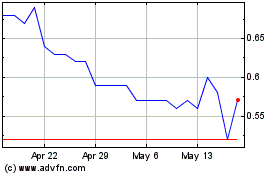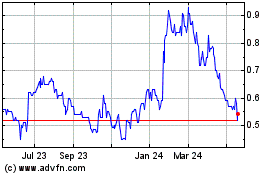Intermap Technologies (TSX: IMP; OTCQB: ITMSF) (“Intermap” or the
“Company”), a global leader in 3D geospatial products and
intelligence solutions, today announced it was contracted to
provide its high-resolution NEXTMap® elevation data and
precision radar imagery to support the United States Geological
Survey (USGS) and NASA’s Artemis III simulations and training
exercises in the Arizona desert.
Intermap’s data is being leveraged by the Joint Extra Vehicular
Activity Test Team (JETT), a specialized group that develops,
integrates and executes tests and analog missions. The JETT is part
of NASA’s Artemis III mission, which intends to land a human crew
near the lunar South Pole in 2025. Test missions are taking place
in the Arizona desert, which has characteristics that are analogous
to a lunar environment. This includes challenging, rugged terrain,
unique geology, and minimal communications infrastructure, all of
which astronauts will experience near the lunar South Pole during
the Artemis missions. Intermap’s NEXTMap digital elevation models
and radar imagery provide accurate 3D information covering the
Arizona JETT exercise area, allowing USGS and NASA to plan and
execute tests to evaluate designs for Extra Vehicular Activities
(EVAs) such as suits and tools, address gaps and risks for lunar
surface operations, and develop capabilities for EVA and scientific
tasks.
The JETT is conducting a series of fully integrated,
mission-scale exercises to ensure successful lunar surface
operations and technology development for the Artemis III mission.
Studies for the Artemis III mission include field hardware
preparation, testing in lunar-like terrain and a fully integrated
simulation consisting of EVAs, scientific evaluations, and flight
control teams at the Johnson Space Center. These studies will
provide crucial data and insight as teams conduct operations in a
simulated lunar environment to practice for the lunar mission in
2025. Elevation data is critical for training missions on Earth to
prepare for space missions.
“Intermap’s sensed elevation data, accurate processing and
seamless mosaic digital elevation models provide USGS and NASA with
key information that extrapolated synthetic data cannot provide
when creating digital terrain twins for scientific and military
applications,” said Patrick A. Blott, Intermap Chairman and CEO.
“Our data enables the JETT to plan and execute operational
exercises that simulate moonwalking missions in an environment
similar to the lunar South Pole. We are proud to support USGS and
NASA’s efforts to prepare Artemis astronauts for a safe and
successful journey to the surface of the Moon.”
Intermap’s data over a test area in Arizona
depicting an environment similar to the Moon
The Artemis III mission is planned to be the first crewed lunar
landing of the Artemis program, and the first crewed lunar landing
since Apollo 17 in December 1972. During Artemis III, two
astronauts will descend to the lunar South Pole on the Human
Landing System and will spend 6.5 days on the lunar surface,
performing at least two moonwalks.
To learn more about the Artemis III mission, visit
nasa.gov/feature/artemis-iii
To learn more about Intermap’s airborne IFSAR elevation and
imagery remote sensing capabilities, visit
https://www.intermap.com/collection.
Intermap Reader AdvisoryCertain
information provided in this news release, including reference to
revenue growth, constitutes forward-looking statements. The words
"anticipate", "expect", "project", "estimate", "forecast", "will
be", "will consider", "intends" and similar expressions are
intended to identify such forward-looking statements. Although
Intermap believes that these statements are based on information
and assumptions which are current, reasonable and complete, these
statements are necessarily subject to a variety of known and
unknown risks and uncertainties. Intermap’s forward-looking
statements are subject to risks and uncertainties pertaining to,
among other things, cash available to fund operations, availability
of capital, revenue fluctuations, nature of government contracts,
economic conditions, loss of key customers, retention and
availability of executive talent, competing technologies, common
share price volatility, loss of proprietary information, software
functionality, internet and system infrastructure functionality,
information technology security, breakdown of strategic alliances,
and international and political considerations, as well as those
risks and uncertainties discussed Intermap’s Annual Information
Form and other securities filings. While the Company makes these
forward-looking statements in good faith, should one or more of
these risks or uncertainties materialize, or should underlying
assumptions prove incorrect, actual results may vary significantly
from those expected. Accordingly, no assurances can be given that
any of the events anticipated by the forward-looking statements
will transpire or occur, or if any of them do so, what benefits
that the Company will derive therefrom. All subsequent
forward-looking statements, whether written or oral, attributable
to Intermap or persons acting on its behalf are expressly qualified
in their entirety by these cautionary statements. The
forward-looking statements contained in this news release are made
as at the date of this news release and the Company does not
undertake any obligation to update publicly or to revise any of the
forward-looking statements made herein, whether as a result of new
information, future events or otherwise, except as may be required
by applicable securities law.
About Intermap
TechnologiesFounded in 1997 and headquartered in Denver,
Colorado, Intermap (TSX: IMP; OTCQB: ITMSF) is a global leader in
geospatial intelligence solutions, focusing on the creation and
analysis of 3D terrain data to produce high-resolution thematic
models. Through scientific analysis of geospatial information and
patented sensors and processing technology, the Company provisions
diverse, complementary, multi-source datasets to enable customers
to seamlessly integrate geospatial intelligence into their
workflows. Intermap’s 3D elevation data and software analytic
capabilities enable global geospatial analysis through artificial
intelligence and machine learning, providing customers with
critical information to understand their terrain environment. By
leveraging its proprietary archive of the world’s largest
collection of multi-sensor global elevation data, the Company’s
collection and processing capabilities provide multi-source 3D
datasets and analytics at mission speed, enabling governments and
companies to build and integrate geospatial foundation data with
actionable insights. Applications for Intermap’s products and
solutions include defense, aviation and UAV flight planning, flood
and wildfire insurance, disaster mitigation, base mapping,
environmental and renewable energy planning, telecommunications,
engineering, critical infrastructure monitoring, hydrology, land
management, oil and gas and transportation.
For more information, please
visit www.intermap.com or
contact:Jennifer BakkenExecutive Vice President and
CFOCFO@intermap.com +1 (303) 708-0955
A photo accompanying this announcement is available at
https://www.globenewswire.com/NewsRoom/AttachmentNg/3b0597ce-51f3-45ca-8978-ec81bb51c1ba
Intermap Technologies (TSX:IMP)
Historical Stock Chart
From Dec 2024 to Jan 2025

Intermap Technologies (TSX:IMP)
Historical Stock Chart
From Jan 2024 to Jan 2025
